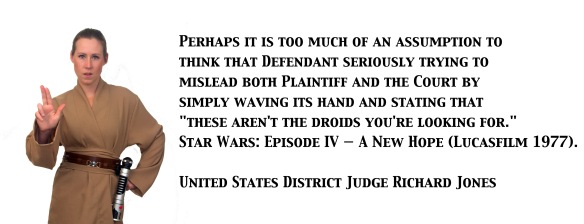The City of New York, 50 unnamed NYPD officers, and the former NYPD Commissioner are involved in a civil rights lawsuit over allegedly issuing summonses without probable cause, violating the First, Fourth, Fifth, Eighth, and Fourteenth Amendments to the U.S. Constitution, if true. The City was found to be grossly negligent in issuing and executing its litigation hold for the preservation of email and text messages. Stinson v. City of New York (S.D.N.Y. Jan. 2, 2016) 2016 U.S. Dist. LEXIS 868, at *1.

The City did not issue a litigation hold until three years AFTER the complaint had been filed. The Court stated that litigation hold was not effectively communicated and the officers listed in the City’s initial disclosures did not acknowledge receiving the hold notice. Stinson, at *3-4.
The NYPD had a document destruction policy of three years for bureau chief memos and four years for monthly performance reports and summonses. Stinson, at *4. The NYPD “did not have a specific policy with regards to the destruction of email communications, it did impose a hard size limit on officers’ inboxes, and that when officers hit that limit, ‘they delete.’” Stinson, at *5. The NYPD document retention and destruction policy did state, “unless specific steps were taken, relevant NYPD documents would be destroyed.” Id.
The Court further explained that 1) the City made no effort to preserve text messages between police officers; and 2) the NYPD had no policy on preserving text messages. Stinson, at *6.
The City of New York produced only a few documents from key players. Id. Moreover, no emails were produced from the former Commissioner, the former Chief of the department, and three other key custodians. In all, the Court noted a total of fewer than 25 emails produced from key players. Stinson, at *7. The City took the position that the “Police Department on the whole did not operate via email.” Stinson, at *8. This assertion was contradicted by emails the Plaintiff acquired from third parties. Id.
The Court found that the City’s litigation hold was both late and ineffective. Moreover, the fact relevant emails were found, demonstrated that relevant emails were also deleted. Id.
Judge Robert Sweet granted the Plaintiff’s motion for sanctions. The Court applied the elements from Chin v. Port Authority in proving sanctions that:
1) That the party having control over the evidence had an obligation to preserve it at the time it was destroyed;
2) That the records were destroyed with a culpable state of mind; and
3) That the destroyed evidence was relevant to the party’s claim or defense such that a reasonable trier of fact could find that it would support that claim or defense.
Stinson, at *8.
The Court found that the duty to preserve was the date of an earlier lawsuit involving quota-related allegations that was “strikingly similar” to the instant case, which was January 31, 2008, opposed to the date of the current lawsuit, filed on May 25, 2010. Stinson, at *10-11, referencing Floyd v. City of New York, 283 F.R.D. 153, 164-66 (S.D.N.Y. 2012).
The parties further battled over the scope of the duty to preserve. While it is unreasonable for any organization to have an indefinite litigation hold, the City could not argue there was any justification in failing to enact a litigation hold for three years. Stinson, at *12. The City further argued that since the Plaintiff’s had overly broad discovery requests, they should not be sanctioned for failing to preserve relevant ESI. Id. The Court rejected this argument, stating:
…[T]he reasonableness or unreasonableness of one party’s demands does not determine the scope of the other party’s obligation to preserve documents. The Plaintiffs’ putative overbroad demands do not excuse the City’s failure to issue a litigation hold, to properly supervise its implementation, or to suspend document retention policies that would foreseeably lead to the spoliation of evidence.
///
The Plaintiffs’ putative overbroad demands do not excuse the City’s failure to issue a litigation hold, to properly supervise its implementation, or to suspend document retention policies that would foreseeably lead to the spoliation of evidence.
Stinson, at *12-13.
Life lesson: Just because the Plaintiff has overly broad scope for discovery requests, does not justify the lack of a litigation hold.
The Court held that the City’s conduct warranted a finding of gross negligence in its failure to issue a litigation hold. Stinson, at *16. The Court explained that finding gross negligence is “more art than science” due to the lack of a clear standard:
Neither negligence or gross negligence has been clearly defined in the context of discovery misconduct, such as spoliation. These terms simply describe a continuum. Conduct is either acceptable or unacceptable. Once it is unacceptable the only question is how bad is the conduct. That said, it is well established that negligence involves unreasonable conduct in that it creates a risk of harm to others.
Stinson, at *16 [Citations omitted].
The Court held the following factors amounted to gross negligence: 1) failure to issue a litigation hold; 2) failure to implement the hold after it was issued with poor communications and the destruction of evidence; and 3) failure to circulate the hold and ensure compliance. Stinson, at *17-18.
Judge Sweet drove home the point the NYPD knew document destruction was foreseeable from their retention policy:
The NYPD cannot credibly argue that, despite setting guidelines for document destruction and providing an industrial shredding truck for that purpose, it did not know or intend that documents would be destroyed. Similarly, Lieutenant Scott’s Rule 30(b)(6) testimony amounts to an admission that the Department knew that officers’ email inboxes would hit their space limits – and that those officers would delete potentially relevant ESI when they did. Although the paucity of relevant emails produced from the inboxes of key decision makers does not establish that ESI was deleted, it is consistent with such spoliation and with Lieutenant Scott’s acknowledgement that deletion of emails was a foreseeable consequence of the NYPD’s storage policy.
Stinson, at *19.
The Court further held that the evidence lost was relevant to the Plaintiff’s claims from the handful of emails that were produced from a third party and other discovery. Stinson, at *20-21.
The Court had to craft a proportional adverse inference instruction based on the City’s conduct. As one would expect, the Plaintiff sought nuclear sanctions that would make them prevail on hotly contested disputes in the case. Stinson, at *22. As the Court explained, the Plaintiff was entitled to “an inference that helpful evidence may have been lost, not relief from their obligation to prove their case.” Id.
The Court sanctioned the Defendants with a “permissive inference” instead of a “mandatory adverse inference.” Id. Judge Sweet explained:
A permissive inference will ensure that the City faces consequences for its failure to take its preservation obligations seriously, but will not result in an unwarranted windfall for the Plaintiffs. The jury will be instructed that the absence of documentary evidence does not in this case establish the absence of a summons quota policy.
Stinson, at *23.
Bow Tie Thoughts
Large organizations often get trapped in the “fog of war” with litigation holds. Failed communications, not monitoring for compliance, or not issuing a hold can result in catastrophic results.
This case did not apply the new Federal Rule of Civil Procedure Rule 37(e), because the motion was submitted prior to the December 1, 2015, the day the Rule went into effect. Stinson, at *14-15, footnote 5. The Court held it would not be “just and practicable” to retroactively apply the Rule. Id. The new Rule 37(e) states:
Failure to Preserve Electronically Stored Information. If electronically stored information that should have been preserved in the anticipation or conduct of litigation is lost because a party failed to take reasonable steps to preserve it, and it cannot be restored or replaced through additional discovery, the court:
(1) upon finding prejudice to another party from loss of the information, may order measures no greater than necessary to cure the prejudice; or
(2) only upon finding that the party acted with the intent to deprive another party of the information’s use in the litigation may:
(A) presume that the lost information was unfavorable to the party;
(B) instruct the jury that it may or must presume the information was unfavorable to the party; or
(C) dismiss the action or enter a default judgment.
USCS Fed Rules Civ Proc R 37(e).
It will be very interesting to see the first case that applies Rule 37(e). Time will tell how quickly that day comes. While the factual analysis will likely remain the same, the sanctions analysis should be less art and more science.













